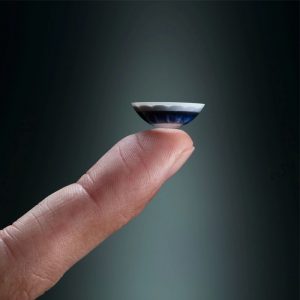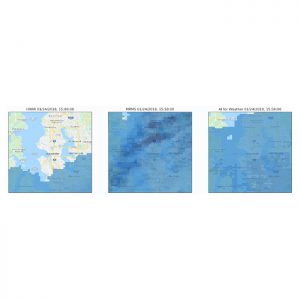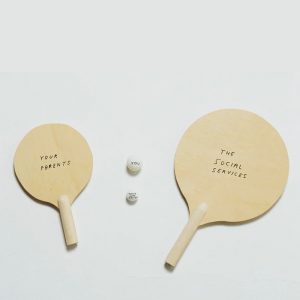Link About It: This Week’s Picks
Ginormous diamonds, living robots made from frog stem cells, and more from around the web

Preserving the Scents of Everyday Life
 Researchers at the UCL Institute for Sustainable Heritage are working double-time to identify and catalog scents that exist all around us—from the smell of an old book, to a pub at a particular time of night, and worn-in leather. Many of these are disappearing right under our noses. For example, as we collectively move deeper into a digital age, books are being read on phones and tablets. As such, the next generation may not recall or even be able to identify the scent of a musty, well-read book. This is cause for alarm for scent researchers, and they believe that odors which are unique to objects, places or cultures should have their own place on UNESCO heritage lists. Read more about the process of extraction, identification, and preservation at BBC.
Researchers at the UCL Institute for Sustainable Heritage are working double-time to identify and catalog scents that exist all around us—from the smell of an old book, to a pub at a particular time of night, and worn-in leather. Many of these are disappearing right under our noses. For example, as we collectively move deeper into a digital age, books are being read on phones and tablets. As such, the next generation may not recall or even be able to identify the scent of a musty, well-read book. This is cause for alarm for scent researchers, and they believe that odors which are unique to objects, places or cultures should have their own place on UNESCO heritage lists. Read more about the process of extraction, identification, and preservation at BBC.
World’s First Living Robots Assembled from Frog Stem Cells
 “These are entirely new lifeforms. They have never before existed on Earth,” Michael Levin, the director of the Allen Discovery Center at Tufts University in Medford, Massachusetts, tells The Guardian. “They are living, programmable organisms.” Levin and other researchers in the US have created the first-ever living machines: robots composed of biological tissue, assembled from African clawed frog (xenopus laevis) stem cells and designed on a super-computer. Less than 1mm long these organisms, called “xenobots,” propel themselves until their energy reserves deplete (roughly one week to 10 days). The US Defense Advanced Research Projects Agency funds this project, and the implications certainly bring up many questions regarding ethics. Read more at The Guardian.
“These are entirely new lifeforms. They have never before existed on Earth,” Michael Levin, the director of the Allen Discovery Center at Tufts University in Medford, Massachusetts, tells The Guardian. “They are living, programmable organisms.” Levin and other researchers in the US have created the first-ever living machines: robots composed of biological tissue, assembled from African clawed frog (xenopus laevis) stem cells and designed on a super-computer. Less than 1mm long these organisms, called “xenobots,” propel themselves until their energy reserves deplete (roughly one week to 10 days). The US Defense Advanced Research Projects Agency funds this project, and the implications certainly bring up many questions regarding ethics. Read more at The Guardian.
Mojo Vision’s Smart Contact Lens Prototype
 After five years of testing, Mojo Vision (a company comprised of former Apple, Google, Amazon and Microsoft executives and engineers) officially toured their smart contact lens prototype. The lens would act as an internal interface, letting the wearer peruse their calendar, devise a route home, and even skip songs currently playing within their earbuds. Though the product’s arrival remains years away, testing involves a VR headset and the interface as it would look inside your eye. Looking to the corner of your eye would reveal text messages and incoming phone calls, and doing so twice would open a larger interface where maps, calendars, and more could be accessed. Read more about the future of wearables at Wired.
After five years of testing, Mojo Vision (a company comprised of former Apple, Google, Amazon and Microsoft executives and engineers) officially toured their smart contact lens prototype. The lens would act as an internal interface, letting the wearer peruse their calendar, devise a route home, and even skip songs currently playing within their earbuds. Though the product’s arrival remains years away, testing involves a VR headset and the interface as it would look inside your eye. Looking to the corner of your eye would reveal text messages and incoming phone calls, and doing so twice would open a larger interface where maps, calendars, and more could be accessed. Read more about the future of wearables at Wired.
Korg Briefly Resurrecting ARP 2600 Synth
 After a 39-year absence, the legendary ARP 2600 is being resurrected by Korg—albeit for a limited run. The semi-modular synth (designed by Dennis Colin for Alan R. Pearlman) was groundbreaking as, at the time, other modular systems had to be bought separately and wired together; the ARP 2600 was pre-wired internally. The synth has “three oscillators with options for sawtooth, square, triangle, sine, and pulse that can be either an audio source or function as an LFO. There’s also a self-resonating low-pass filter, a noise generator and ring modulator, plus a spring reverb tank. And, of course, two envelope generators for controlling the attack, decay, sustain and release of your notes and filter.” There will be some new additions too. For instance, it will support aftertouch and portamento, as well as “its own dedicated LFO built in and an arpeggiator.” This iconic synth has been famously used by the likes of Brian Eno, David Bowie, Kraftwerk, Stevie Wonder, Joy Division and countless others. Find out more at Engadget.
After a 39-year absence, the legendary ARP 2600 is being resurrected by Korg—albeit for a limited run. The semi-modular synth (designed by Dennis Colin for Alan R. Pearlman) was groundbreaking as, at the time, other modular systems had to be bought separately and wired together; the ARP 2600 was pre-wired internally. The synth has “three oscillators with options for sawtooth, square, triangle, sine, and pulse that can be either an audio source or function as an LFO. There’s also a self-resonating low-pass filter, a noise generator and ring modulator, plus a spring reverb tank. And, of course, two envelope generators for controlling the attack, decay, sustain and release of your notes and filter.” There will be some new additions too. For instance, it will support aftertouch and portamento, as well as “its own dedicated LFO built in and an arpeggiator.” This iconic synth has been famously used by the likes of Brian Eno, David Bowie, Kraftwerk, Stevie Wonder, Joy Division and countless others. Find out more at Engadget.
Testing for 3D Vision in Cuttlefish
 Though octopuses and squids are not capable of seeing in 3D, cuttlefish do boast depth-perception, recent research studies at the University of Minnesota confirmed. When donning 3D glasses, the cuttlefish could not only detect a shrimp (which comprised of projected images in two different colors and at two different distances), but also actively position itself for an attack. After identifying the shrimp, the fish backed up, aimed, and fired its tentacles at the silhouette. Later, thanks to a bit of trickery, the shrimp appeared farther away. The cuttlefish creeped toward it and lunged, suggesting it could tell that the silhouette seemed farther away, despite not being able to discern the digital from the physical world. Read more at The New York Times.
Though octopuses and squids are not capable of seeing in 3D, cuttlefish do boast depth-perception, recent research studies at the University of Minnesota confirmed. When donning 3D glasses, the cuttlefish could not only detect a shrimp (which comprised of projected images in two different colors and at two different distances), but also actively position itself for an attack. After identifying the shrimp, the fish backed up, aimed, and fired its tentacles at the silhouette. Later, thanks to a bit of trickery, the shrimp appeared farther away. The cuttlefish creeped toward it and lunged, suggesting it could tell that the silhouette seemed farther away, despite not being able to discern the digital from the physical world. Read more at The New York Times.
Improved Weather Forecasts Made Using Neural Networks
 Using a vast neural network capable of making ultra-quick decisions based on images and predictive learning (rather than physics or meteorology), Google researchers may have finally figured out how to make weather forecasts hour by hour. Traditionally, weather forecasts have taken up to three hours to form, and thus are a little less accurate. As for Google’s, their neural network can formalize a report in less than 10 minutes. The faster technology finds real-life application when users want weather updates before popping out for a run, commuting, or planning an evening’s itinerary. Plus, because the neural network is examining rain-pattern imagery and not scientific data points, it can provide detailed forecasts for particular neighborhoods and stretches of remote land. Read more at Ars Technica.
Using a vast neural network capable of making ultra-quick decisions based on images and predictive learning (rather than physics or meteorology), Google researchers may have finally figured out how to make weather forecasts hour by hour. Traditionally, weather forecasts have taken up to three hours to form, and thus are a little less accurate. As for Google’s, their neural network can formalize a report in less than 10 minutes. The faster technology finds real-life application when users want weather updates before popping out for a run, commuting, or planning an evening’s itinerary. Plus, because the neural network is examining rain-pattern imagery and not scientific data points, it can provide detailed forecasts for particular neighborhoods and stretches of remote land. Read more at Ars Technica.
Airbus’ “Flying Whale” Beluga XL Aircraft Enters Service
 With a bulbous nose, the Airbus Beluga XL aircraft delightfully resembles the underwater mammal it was named for. Referred to as the “flying whale,” the plane’s whimsical design was selected through a poll of roughly 20,000 Airbus staff members (it garnered 40% of the vote). One of the biggest planes to the take to the sky, this super-transporter cargo vessel will fly aircraft components between production sites and assembly lines in Europe and China. Its highly anticipated inaugural flight was on 9 January. Read more at CNN.
With a bulbous nose, the Airbus Beluga XL aircraft delightfully resembles the underwater mammal it was named for. Referred to as the “flying whale,” the plane’s whimsical design was selected through a poll of roughly 20,000 Airbus staff members (it garnered 40% of the vote). One of the biggest planes to the take to the sky, this super-transporter cargo vessel will fly aircraft components between production sites and assembly lines in Europe and China. Its highly anticipated inaugural flight was on 9 January. Read more at CNN.
Louis Vuitton Purchases The Second-Largest Rough Diamond Ever
 Found inside a mine in Botswana last April, the second-largest rough diamond ever documented—at a whopping 1,758 carats—recently sold to Louis Vuitton. While the brand is best known for their leather goods and apparel, the purchase of the Sewelô (as the stone is called) is evidence of their commitment to the high-end jewelry market. This comes shortly after parent company LVMH’s acquisition of Tiffany & Co—for $16.2 billion dollars in cash. In the $270-billion global jewelry market, Vuitton aims to stand out for unique stones and designs, rather than emulating classic styles from other brands. While the official number has not been announced, Vuitton likely spent somewhere between $50 and $60 million on the stone, and executives plan to send it on its own grand tour before returning it to the workshop, where gemologists will asses its interior, as the exterior is “still slicked with carbon.” Read more at the Financial Times.
Found inside a mine in Botswana last April, the second-largest rough diamond ever documented—at a whopping 1,758 carats—recently sold to Louis Vuitton. While the brand is best known for their leather goods and apparel, the purchase of the Sewelô (as the stone is called) is evidence of their commitment to the high-end jewelry market. This comes shortly after parent company LVMH’s acquisition of Tiffany & Co—for $16.2 billion dollars in cash. In the $270-billion global jewelry market, Vuitton aims to stand out for unique stones and designs, rather than emulating classic styles from other brands. While the official number has not been announced, Vuitton likely spent somewhere between $50 and $60 million on the stone, and executives plan to send it on its own grand tour before returning it to the workshop, where gemologists will asses its interior, as the exterior is “still slicked with carbon.” Read more at the Financial Times.
MAAT’s Playmode Exhibition Intertwines Art and Games
 Playful but precise and poignant, the Playmode exhibition (curated by Filipe Pais and Patrícia Gouveiaat and on now through 17 February) at Lisbon’s Museum of Art, Architecture and Technology features works by David Shrigley, Mary Flanagan and plenty of others. The work range from dark and conceptual to entertaining and emotionally informative, and span visual art and gaming to form coherent narratives about life and death, international relations, gun violence and more. For example, David Shrigley’s ping-pong table doubles as tragic tale of being tossed between parents and protective services, while Joseph Delappe’s piece is a modified version of the video game Grand Theft Auto which conveys the gun violence epidemic unfolding in real life in the US. See more at designboom.
Playful but precise and poignant, the Playmode exhibition (curated by Filipe Pais and Patrícia Gouveiaat and on now through 17 February) at Lisbon’s Museum of Art, Architecture and Technology features works by David Shrigley, Mary Flanagan and plenty of others. The work range from dark and conceptual to entertaining and emotionally informative, and span visual art and gaming to form coherent narratives about life and death, international relations, gun violence and more. For example, David Shrigley’s ping-pong table doubles as tragic tale of being tossed between parents and protective services, while Joseph Delappe’s piece is a modified version of the video game Grand Theft Auto which conveys the gun violence epidemic unfolding in real life in the US. See more at designboom.
Link About It is our filtered look at the web, shared daily in Link and on social media, and rounded up every Saturday morning.











